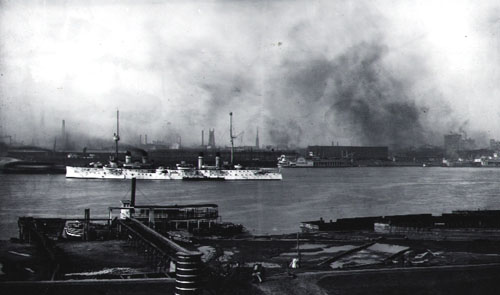
"It [steamboating] killed the old-fashioned keel-boating, by reducing the freight-trip to New Orleans to less than a week. The railroads have killed the steamboat passenger traffic by doing in two or three days what the steamboats consumed a week in doing; and the towing-fleets have killed the through-freight traffic by dragging six or seven steamer-loads of stuff down the river at a time, at an expense so trivial that steamboat competition was out of the question."

These two photographs were probably taken at about the same time, ca. 1905, yet they seem to be of two eras entirely, the one showing a small oyster boat powered by paddle wheel and, for good measure, by sail, and the other several warships headed into the port. The New Venus (above) is listed as a gasoline launch in the 1905-1906 Annual Report of the Board of Commissioners of the Port of New Orleans. The warships (below) cannot be positively identified, but they may be two of the many French and U.S. ships that gathered in port for the celebration of the Louisiana Purchase Centennial in December, 1903. "Often the people of New Orleans have seen one and two ships of war lying off the city," the Daily Picayune wrote of the gathering of the fleets, "but it has been nearly fifteen years since there has been so many vessels here at one time." [December 17, 1903, p. 1][C. Milo Williams Collection]

Small oyster boats like the one here took their catch in the oyster beds off the Louisiana coast and brought it through the bayous and canals and up the river to the oyster lugger landing between St. Philip and Ursuline streets. Ocean-going ships like the warships in the adjoining photograph were guided through the harbor by river pilots (after 1908 by pilots from the Crescent River Port Pilots Association) to dock along the miles of wharves that were continually being constructed during the late 19th and the 20th centuries. Then, as now, the river was "alive with use" (as it was recently and aptly described by author Norah Deakin Davis). Over time, the river has accommodated all sorts and sizes of crafts, from the small sailing ships, schooners, luggers, skiffs, scows, rafts, keelboats and flatboats of its early days to the larger steamships, steamboats, packets, towboats and ferries, and finally the mammoth cruise ships, tankers, cargo carriers, and long lines of barges that glide in and out of the port today. Although the birth of one mode of transport has often meant the death of another, the river has accommodated each in its own day, and the life of the port evolves and endures.
"The New Orleanian likes his river," Lyle Saxon wrote in Fabulous New Orleans. "He likes to walk upon the docks to look at the Mississippi. . . . It is an old custom, this going down to the levee. For the river is fascinating almost always." But for much of the 20th century, the river was hidden from view by miles of wharves, and the old custom of relaxing on the levee and watching all the different kinds of vessels pass by, of necessity, died out. In the last 25 years or so, however, the riverfront has begun to open up again in spots--at the Moonwalk, opposite Jackson Square; at the "Riverview" behind Audubon Park; at Woldenberg Park and at the Riverwalk, the site of the 1984 World's Fair--and the New Orleanian has once again been introduced to the river and the sight of ships of all sizes moving in and out of port.
 Back to River Exhibit Main Page
Back to River Exhibit Main Page
iw/we 5/1998